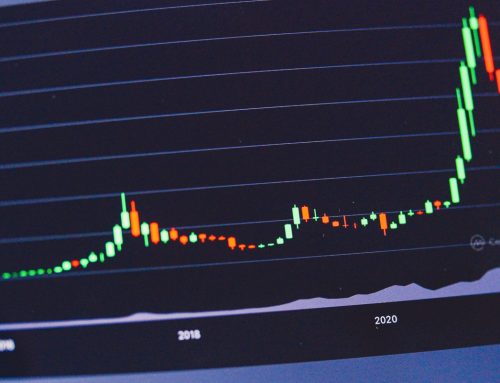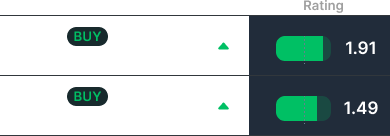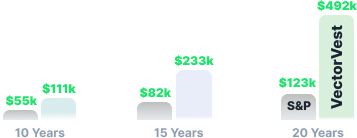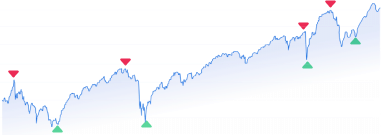The best investors don’t rely on outdated technical or fundamental analysis. Although they understand the principles, they recognize that the smarter way to boost their success rate and win more trades is with the right support.
Morningstar has long been known for its portfolio analysis tools, investment screeners, and research reports, along with its ratings on mutual funds, ETFs, and individual stocks. But today’s investor needs more from their toolkit. That’s why we’re going to unpack the best Morningstar alternatives.
Whether you’re looking for the best alternatives to Morningstar for swing trading or day trading, long-term investing or even options trading – there’s a solution on our list tailored to your exact needs. But really, the last tool you’ll ever need in your arsenal is VectorVest.
Our stock analysis software brings winning opportunities to your fingertips on a daily basis, each with a clear buy, sell, or hold recommendation you can trust. The system has outperformed the S&P 500 index by 10x over the past 20+ years, all while saving our investors time and stress.
Join over a million investors who rely on VectorVest to earn better returns, consistently. Try the system risk-free for 30 days and you’ll never go back to trading or investing the old way.
What is Morningstar?
Morningstar is one of the most established names in investment research, especially for those who trade mutual funds and want comprehensive fundamental data to inform decision-making.
The company was founded in 1984 with the goal of helping everyday investors understand the strengths and weaknesses of mutual funds with its now-famous star rating system. Over the past four decades and counting it has expanded into stock research, portfolio management tools, and retirement planning resources.
Today, Morningstar offers a mix of free content and premium services. Its premium tier gives you access to analyst reports, proprietary stock and fund ratings, and portfolio X-ray tools to help you evaluate risk, fees, diversification, and long-term performance.
Morningstar brings retail investors institutional-grade research and data transparency to level the playing field. It takes a long-term, fundamentals-first approach that aligns well with passive investors, value investors, and retirement-focused users.
But that leaves quite the gap for users who want to day trade, swing trade, options trade, or simply take a more active approach to managing their portfolio. You can still get some value from Morningstar if you fall under one of these umbrellas, but enough to justify the subscription cost? Probably not.
It doesn’t cut it for those who are serious about their finances. That’s why more and more users are cancelling their subscriptions and seeking out the best alternatives to Morningstar.
Why Look for a Morningstar Alternative?
Morningstar still holds value for many investors, but it’s not a perfect fit for everyone – especially active traders who want real-time data to inform their decision-making on a daily basis. Here are some of the reasons our customers come to us looking for Morningstar alternatives.
Antiquated Analysis Tools
Morningstar’s methodology has changed very little over the years. The star rating system and Morningstar Analyst Ratings are familiar if you’ve used the solution in the past, but you’re relying heavily on long-form research reports and manual interpretation.
This is time-consuming and hard to act on. By the time you’ve interpreted the numbers and charts and come up with a trading plan, the window of opportunity may have closed. Or worse, you could have missed your chance to sell – what was supposed to be a winner is now a loser.
Morningstar doesn’t offer technical charting, buy/sell signals, or momentum-based tools that many other platforms now provide as standard. This alone is reason enough to look into Morningstar alternatives.
It Doesn’t Provide Enough Value For the Money
The cost of Morningstar Premium is another barrier. At $249/year, it’s hard to justify for investors who aren’t using every aspect of the platform. That’s not to say Morningstar is expensive. Just that there may be a value disconnect in the eyes of some investors.
The reports are well-researched – there’s no arguing on that front. But are they actionable? Far from it. You could pay a little more and get real, meaningful recommendations that save you time and stress, empowering you to win more trades with less work.
What Real Users Said
We know every review needs to be taken with a grain of salt, as a lot of people have unrealistic expectations from investment apps for beginners. They think they’ll never lose a trade again and when they inevitably do, they blame the system.
That said, we’ve taken a look at the Morningstar Trustpilot page and found a few common themes. First, let’s talk about the 1.6/5 star rating. That’s hard to look past on its own. But what people are actually saying is worth a closer look as well:
“I have used the watchlist functionality of Morningstar for probably 2 decades. Morningstar has now become obsolete as you can’t use the watchlist functionality anymore without a paid subscription.” – Marco
“Extremely poor service! They kept on charging my account even after i had cancelled my subscription. The customer service is slow and only responds swiftly to reviews.” – John
“I wouldn’t give one star, except that’s the only way I can actually make this review. Morningstar is highly complex, without customer service that can simplify the process of reviewing stocks and creating portfolios. I’ve had Morningstar for years and still barely know how to use it. Say no to Morningstar there’s many many programs out there.” – Julie
Julie said it best – there are many other programs out there to choose from. That’s the beauty of stock pickers and portfolio management systems. What works for some people will fall short for others, and that’s perfectly fine. We’ll help you find the best Morningstar alternatives below.
The Top Morningstar Alternatives in 2025
Morningstar isn’t your only option. And depending on how you trade, it’s definitely not the best one. Let’s look at a few alternatives to Morningstar that bring you more intuitive analysis, faster insights, and tools designed for how you actually invest in today’s market.
VectorVest
The VectorVest stock advisory is the smartest way to analyze and manage your investments without spending hours pouring over spreadsheets or charts. It’s all built on a proprietary stock rating system that tells you what to buy, when to buy it, and when to sell it.
The VST (Value, Safety, Timing) System tracks and rates over 18,000 stocks daily and puts them on a simple scale of 0.00-2.00, with 1.00 being the average. Just pick safe, under-valued stocks rising in price (those with a rating above 1.00) and win more trades!
You can customize your screeners and get a glimpse of market sentiment at any given time so you know when conditions are favorable and when you may want to sit on the sidelines and wait.
The real value of VectorVest, though, is in the real-time data you gain access to. We pull from the Nasdaq Last Sale (NLS) feed so you can make timely decisions. We’re the only system that offers this feature to retail investors right now.
You never have to worry about where your next opportunity is going to come from, either. Our pre-curated range of stock screeners makes it easy to filter based on stocks that align with your strategy – be it undervalued stocks, those with high momentum, super safe stocks, or industry-specific companies you’re interested in trading.
The VectorVest system supports a variety of trading strategies, whether you’re a swing trader or options trader or even trying to manage a retirement portfolio. We’re also the only system that shows you our track record dating back more than two decades, because we believe transparency around our calls is important to upholding trust with our investors.
You’ll discover a range of free resources and training courses on our website as well. We’re not just here to give you trading tools; we want to empower you through education as well. VectorVest lets you connect to certain brokerages to streamline your trade execution, too.
The VectorVest system has earned the trust of over a million investors with a 4.7 star rating from over 15,000 independently published reviews. So, don’t just take our word for it when we tell you this is the best Morningstar alternative.
“Excellent set of tools…I consistently beat all my professionally managed accounts. Really can’t imagine not having them part of my daily routine.”
“With this tool I can check any stock and make the right call most of the time. It has simplified things for me. My portfolio is going gang busters.”
“have had very good success with VectorVest. I’ve made 50-60% returns annually for the last 6 years with their systems. All I can say, if you follow them to a T you will succeed.”
Get the best stock app for iPhone or the best Android stock app today at VectorVest. See the system in action with a free stock analysis and find out firsthand how much easier investing can be!
Seeking Alpha
Seeking Alpha built its reputation on crowdsourced investment research, and its unique approach has earned it a place on our list of Morningstar alternatives.
Your subscription gets you access to thousands of articles, written by investors and analysts, covering individual stocks, sectors, and macroeconomic trends.
The platform also provides Quant Ratings that rank stocks based on value, growth, profitability, EPS revisions, and momentum. This is updated daily using real data you can depend on. What you may not be able to depend on, though, is the recommendations themselves.
That’s because of the opinion-heavy nature of Seeking Alpha. You always have to question the motives behind the contributors, as they may hold certain stocks or have short positions open on them. Even if they don’t have ulterior motives, there’s no telling how credible they are.
Still, Seeking Alpha is one of the few platforms where you can read bullish and bearish opinions side-by-side and make your own informed decision. Premium users unlock exclusive stock picks, author performance metrics, and deeper valuation data.
You can also create watchlists and customize alerts for earnings, price movements, and news headlines. But, at the end of the day you’re still going to have to filter through analysis yourself, which is why VectorVest is also the #1 Seeking Alpha alternative.
Zacks
Zacks is known for its earnings-based stock rating system – the Zacks Rank. This methodology classifies stocks from #1 (Strong Buy) to #5 (Strong Sell) based on changes in analyst earnings estimates. It has worked for a long time, earning it consideration for alternatives to Morningsar.
You also get screening tools, mutual fund and ETF rankings, in-depth equity research reports, and model portfolios. Premium and Ultimate plans unlock more picks, proprietary lists like “Zacks Top 10 Stocks,” and tools for spotting under-the-radar opportunities you may have otherwise missed.
Zacks is all about using quantitative momentum factors tied to earnings surprises and estimate revisions. It’s especially useful if you’re focused on earnings season or looking for stocks with strong analyst sentiment shifts.
What if you prefer to trade outside of earnings cycles, though? Zacks may not be the right fit for your strategy. It’s also important to note that you won’t get any sort of portfolio management or integrated trading tools, either. It may be just one component in your tech stack.
We wrote a more comprehensive review of VectorVest vs Zacks if you want to learn more.
The Motley Fool
The Motley Fool isn’t a research platform in the traditional sense. Rather, it’s a stock recommendation service with a heavy focus on long-term, buy-and-hold growth investing. Sounds like one of the more apples-to-apples Morningstar alternatives!
The flagship service (Stock Advisor) gives you two new stock picks each month, plus ongoing guidance for a curated portfolio of high-conviction ideas. You can upgrade to a higher tier for more ideas if you’d like.
Each pick comes with a detailed investment thesis, risk factors, and a long-term outlook based on qualitative and quantitative research. You also get rankings of existing recommendations and updates when it’s time to reconsider a position.
It’s hard to argue against The Motley Fool as far as the track record goes. It has outperformed the S&P 500 over multi-decade windows. However, the platform isn’t customizable. You’re following their ideas, not building your own screening criteria or applying technical strategies.
That’s not necessarily a bad thing. A lot of investors are perfectly content with a “just tell me what to buy” approach rather than learning the “why” behind the recommendation, and then being able to form their own screening and analysis methodology.
But if you want more control over your investment strategy, you may find VectorVest to be a smarter Motley Fool alternative.
Stock Rover
Stock Rover is built for investors who thrive on fundamentals. It covers over 8,500 North American stocks and 4,000 ETFs, with access to more than 700 financial metrics.
You can screen stocks using valuation ratios, quality scores, dividend metrics, growth rates, and even forward-looking estimates. But, it’s the intuitive custom scoring system that makes Stock Rover unique.
This lets you build out your own equations to rate stocks based on the exact financial traits you care about. Or, you can use pre-built scoring systems like “Margin of Safety” or “Warren Buffett-style” models.
Along with the main feature, you gain access to strong portfolio analytics, including Monte Carlo simulations and performance attribution. It’s a clean, modular, and highly customizable solution – albeit with a really steep learning curve.
Stock Rover gives you everything you could ever ask for if you feel comfortable digging into balance sheets and running multi-factor screeners. Otherwise, you may be drawn to something more straightforward, such as VectorVest.
TradingView
TradingView started as a technical charting tool, and it’s still one of the best platforms for that purpose today. The platform supports virtually every type of chart (candlestick, Heikin Ashi, Renko, and more) with dozens of drawing tools and hundreds of technical indicators.
You can layer in volume profiles, set custom alerts, and script your own strategies using Pine Script. It’s ok if you’re reading along and feeling a bit lost – TradingView just might not be the best Morningstar alternative for you since it’s so sophisticated and algorithmic.
Beyond charting, TradingView offers stock screeners, watchlists, and a social community where traders share ideas and analysis. You can explore popular scripts, backtest strategies, or follow real-time trade setups from other users if you’re not sure where to begin.
But, a lot of users come to VectorVest looking for a TradingView alternative because it’s just so complicated and overwhelming at times. More than 100 million investors use TradingView, but that doesn’t mean you have to!
Finviz
Finviz (short for Financial Visualizations) is a browser-based stock screening and charting tool known for its speed and simplicity. The free version gives you access to a visual heat map of the market, fundamental and technical stock screeners, basic charting, insider trading data, and performance snapshots by sector or industry.
But the paid tiers unlock more sophisticated insights and tools. You can run quick filters using dozens of preset and custom criteria, like P/E ratio, EPS growth, insider ownership, and RSI. You can stack multiple filters together and instantly surface stocks that meet your strategy.
Finviz Elite brings you real-time data, advanced backtesting, email alerts, intraday charts, correlation tools, and exportable screener results. It’s still somewhat bare-bones when it comes to deeper financial modeling or portfolio tracking, but it works wonderfully for finding opportunities.
That said, our Finviz alternative does both – you can bring the best opportunities to your screen daily and figure out which actually deserves further attention with the VectorVest VST system.
Empower
Empower was formerly known as Personal Capital. It started as a personal finance dashboard but has since evolved into a surprisingly robust investment tool for long-term, passive investors. You can easily link your accounts (brokerages, banks, retirement funds) to pull your holdings into one central interface.
From there, you’ll benefit from portfolio analysis tools like asset allocation breakdowns, retirement planning simulations, investment fee tracking, and a risk assessment model that compares your current allocation to your risk tolerance and goals. You’ll also see historical performance (relative to benchmarks) and get recommendations on rebalancing.
That’s all great if you’re just focused on retirement planning. But it leaves a lot to be desired for active traders compared to other Morningstar alternatives. It doesn’t offer screeners, charting, or technical tools. A lot of free users complain about being hassled for the paid wealth management service, too.
Yahoo! Finance
One of the simplest alternatives to Morningstar is Yahoo! Finance, which has long been a go-to resource for real-time quotes, financial news, and earnings calendars. The free platform gives you a snapshot of a stock’s price history, key financials, analyst estimates, and news flow.
Yahoo Finance Premium is really what we’re interested in breaking down as it pertains to Morningstar alternatives, though. You’ll unlock fair value analysis powered by Morningstar, enhanced charting features, portfolio performance tracking, and curated investment ideas.
Their “Investment Ideas” section is based on factors like undervalued large caps, growth-at-a-reasonable-price (GARP), or technical breakouts. There’s just one problem: depth is pretty limited. You can’t backtest strategies, build custom screeners with complex metrics, or dig into in-depth stock reports.
Fidelity
Finally, we have Fidelity – which is technically a brokerage, but one worth considering as a Morningstar alternative nonetheless. Its research platform is one of the strongest available, so it makes sense if you’re already using the system to execute trades or manage a portfolio.
You get access to in-depth equity research from 20+ third-party firms, including CFRA, Zacks, and Morningstar itself. Their proprietary tools include Equity Summary Scores, stock comparison matrices, and sector-based screeners.
Meanwhile, the Fidelity Stock Screener lets you filter using 140+ criteria, including valuation, growth, and risk factors. Their Active Trader Pro desktop app offers advanced charting and real-time analytics for more active investors.
The learning center on Fidelity’s website rivals that of ours here at VectorVest, so you can learn the ins and outs of investing in general and feel more confident in your abilities.
You’ll just need a Fidelity account to access some of the advanced features, but there’s no platform fee. That said, it’s probably not the right fit for most active traders who rely on more meaningful real-time data.
Wrapping Up Our List of the Best Alternatives to Morningstar
That does it for our list of Morningstar alternatives. Although this solution has its place still to this day, you expect more from your investment tools and research arsenal. Rightfully so. There are plenty of alternatives to Morningstar, and we hope you feel confident in which fits your needs.
Whether you’re comparing Trade Ideas vs VectorVest or any other Morningstar alternatives, we believe our system’s track record of success speaks for itself. It’s also one of the simplest alternatives to Morningstar, so you get back valuable time that used to be spent on analysis.
We don’t just show you the data. We tell you what to do with it. Get started with VectorVest and start trading with less guesswork so you can enjoy more gains!
What you should do next…
- Get our latest blogs delivered right to your inbox, subscribe to our newsletter.
- The market moves fast! Get our most current evaluation of this stock with our FREE stock analysis tool.
- Looking for stock picks? Not sure if now is the right time to buy/sell? For a limited time, enjoy the full benefits of a 30-day subscription to VectorVest for only [offer_txt] (usually up to [saving_txt]/month) . Get access to our full list of screeners showcasing our top stock picks that tell you exactly what to buy, when to buy, and when to sell.












